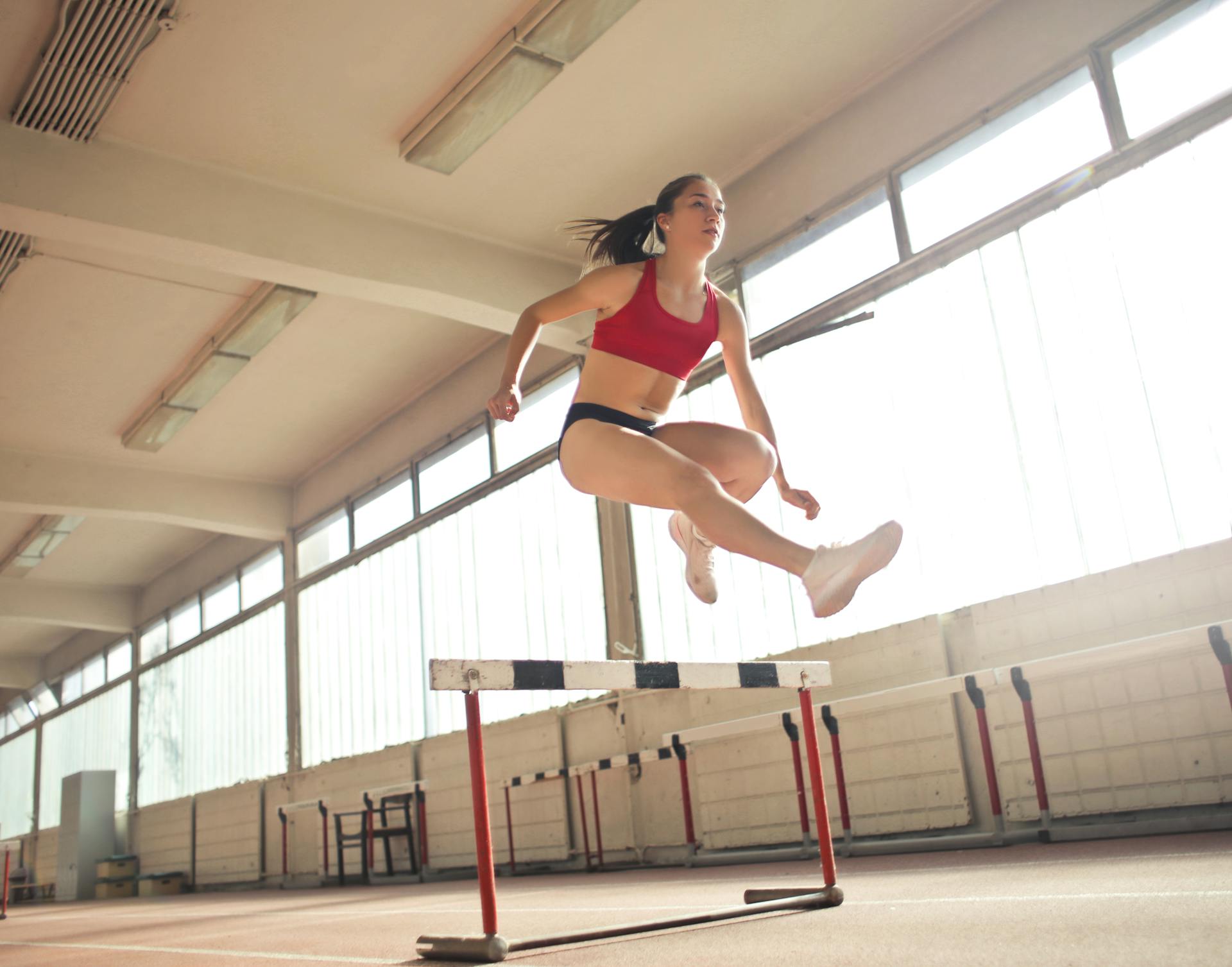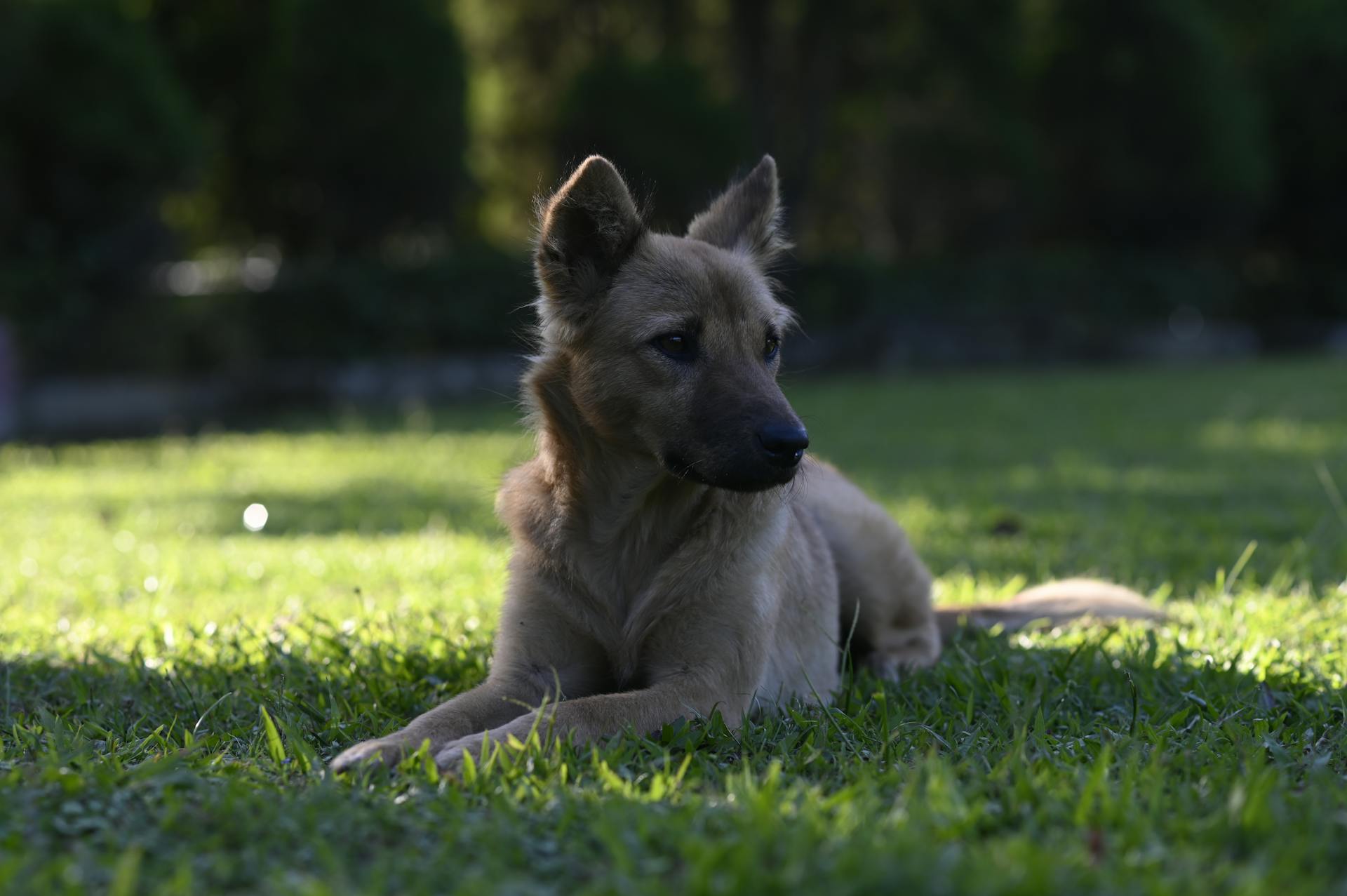
Dog agility training is a fun and rewarding way to challenge your dog physically and mentally. It's a great way to bond with your dog and improve their obedience skills.
Dogs can start agility training as young as 6 months old, but it's best to wait until they have had all their vaccinations and are physically developed enough to handle the demands of agility training. This usually means waiting until they are at least 12 months old.
Agility training involves navigating your dog through a course of tunnels, jumps, weave poles, and other obstacles. The goal is to complete the course in the shortest time possible while maintaining a safe and fun experience for your dog.
With patience, consistency, and positive reinforcement, you can help your dog become a confident and skilled agility dog.
Expand your knowledge: Old Dog Shows
Competition Basics
Most dog agility competitions are hosted by a specific local club, which might be devoted solely to dog agility or host many types of dog sports.
The club contracts with licensed judges and applies to the sanctioning organization for permission to hold a trial on a specific date or weekend.
Trials are usually two-day weekend events, giving dogs and their handlers ample time to showcase their skills.
To get started in dog agility, it's essential to introduce your dog to the equipment, which includes jumps, tunnels, the A-frame, dogwalk, teeter-totter, weave poles, and the table.
Introductory classes like Intro to Obstacles, Intro to Agility, Agility Basics or Foundation are perfect for this purpose, teaching your dog to navigate these obstacles in a fun and safe environment.
These classes are usually the first step in a dog's agility training journey, laying the foundation for more advanced training and competition.
Expand your knowledge: Dog Agility Size Classes
Obstacles
Obstacles are a crucial part of dog agility training, and they come in various forms.
Contact obstacles require dogs to ascend and descend ramps, and place a paw on a "contact zone" that's painted a different color.
The A-frame is a type of contact obstacle that consists of two ramps meeting in the middle, forming an A shape, with varying dimensions depending on the organization running the competition.
The dog walk is another contact obstacle that features an elevated plank with ascending and descending ramps at each end.
Tunnels are a type of obstacle that involve tunnels of different designs for dogs to run or crawl through.
In some classes, dogs navigate through barrels, hoops, and tunnels without any jumping, weaving, or climbing involved, making it a great option for puppies or older dogs with joint issues.
Explore further: Dog Agility Tunnels
Contact Obstacles
Contact obstacles are a crucial part of dog agility training, requiring dogs to ascend and descend planks and ramps while placing a paw on a designated "contact zone".
The A-frame is a classic contact obstacle made of two ramps meeting in the middle to form an A shape. The ramps can vary between 6 feet 8 inches and 9 feet in length.
Dogs need to be agile and confident to navigate the A-frame's varying heights, which can range from 4 feet 11 inches to 6 feet 3 inches at the apex.
The dog walk is another essential contact obstacle, featuring an elevated plank with ascending and descending ramps at each end. The ramps can be between 8 and 12 feet in length.
The height of the elevated plank above the ground can range from 36 to 50 inches, requiring dogs to be precise and controlled in their movements.
Dogs need to be able to place a paw on the contact zone, which is typically painted a different color, to successfully complete the obstacle.
Training
Training is a crucial part of developing your dog's agility skills. To begin, you'll need to enroll your dog in a beginner class, which typically lasts 6 weeks and covers foundation skills.
Agility classes are designed for dogs of all ages, but some classes have prerequisites, such as basic obedience or completion of previous classes. For example, the Beginner Handling class requires completion of Intro to Obstacles.
Classes are usually held for a set number of weeks, with prices varying depending on the location and duration. For instance, a 5-week class at K9U Chicago costs $250.00.
Worth a look: Conformation Dog Show Classes
Course Design
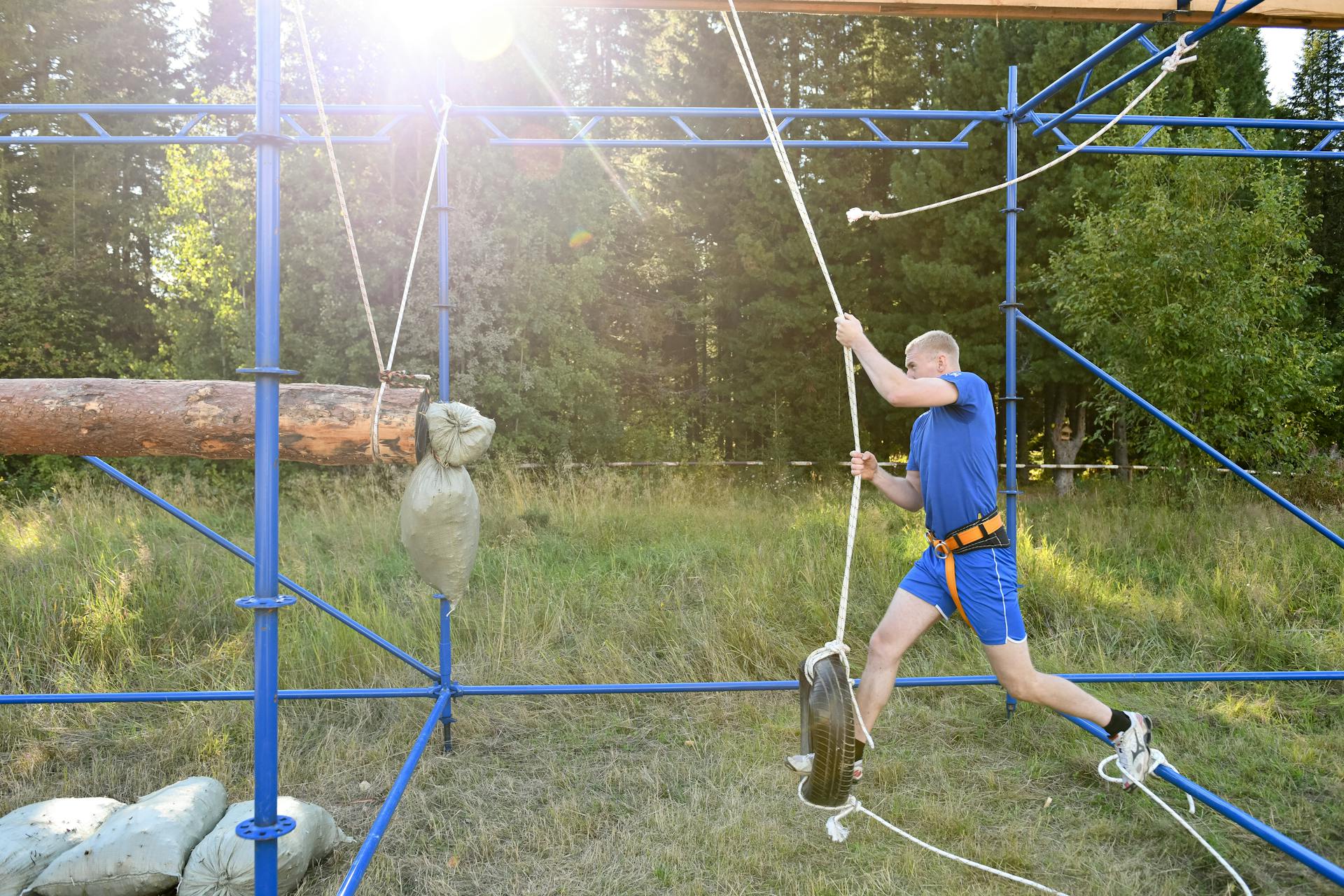
Course design is a crucial aspect of training, and it's essential to understand the process. Judges design the courses before the competition, and the sanctioning organization reviews and approves them to ensure they meet the guidelines.
The guidelines specify issues like obstacle spacing, turn requirements, and obstacle types. The rules vary by competition level and organization. Course designers must consider these factors to create a challenging yet safe course for the dogs.
Before building the course, judges provide course maps to the course builders. The chief course builder is usually an experienced competitor who knows the rules and can direct volunteers to efficiently place the equipment. Course maps are often printed on a grid to make the job easier.
The course builders mark the course to correspond to the grid, and posts are set 10 feet apart. This helps ensure that the course is accurate and consistent.
Suggestion: Dog Agility Course Maps
Ready for Training?
You'll need to start with the basics if you're new to agility training. Begin with the Intro to Obstacles class to learn how to direct your dog from one obstacle to the next. This is a prerequisite for the Beginner Handling class, where you'll start running courses and games.

If you're looking for a more structured approach, consider enrolling in a Beginner Agility class. These classes are designed for dogs 4 months and older who have already completed basic obedience. Your dog will learn to safely and independently complete obstacles like jumps and tunnels, as well as understand your body language.
The first step is to find a class that suits your dog's needs. You can search for agility classes at an AKC Club or check out the United States Dog Agility Association (USDAA) directory for agility groups in your state.
Here are some options to consider:
- Intro to Obstacles: Learn the basics of directing your dog through obstacles.
- Beginner Handling: Start running courses and games with your dog.
- Beginner Agility: Learn foundation skills and introduce your dog to obstacles like jumps and tunnels.
Remember to check the prerequisites for each class and make sure your dog meets the age and obedience requirements. With the right training and guidance, you and your dog can have fun and succeed in agility training.
K9 Training Classes Schedule
Our K9 training classes schedule is packed with exciting options for you and your furry friend. If you're interested in agility training, we offer classes for Basic, Intermediate, and Advanced levels.
You can choose from classes that last 5 weeks, with a cost of $250.00 per class. Classes are held on different days and times, so be sure to check the schedule carefully.
Here's a breakdown of our agility training classes schedule:
Remember to register early, as classes fill up quickly. We also offer private lessons for dogs that may not be suitable for group classes.
Intermediate
The intermediate level of agility training is a crucial step in your dog's development. You've likely already come to love agility and the connection it brings you and your canine friend.
At this level, your dog will learn to navigate contact obstacles and weave poles, as well as more complex skills like handler body and footwork. This is a significant step up from the beginner level, and it's essential to have a solid foundation in place.
To progress to intermediate agility, your dog should have completed the beginner or puppy class at both levels and been approved by the trainer to move on. This class will introduce short sequences for you and your dog to complete.
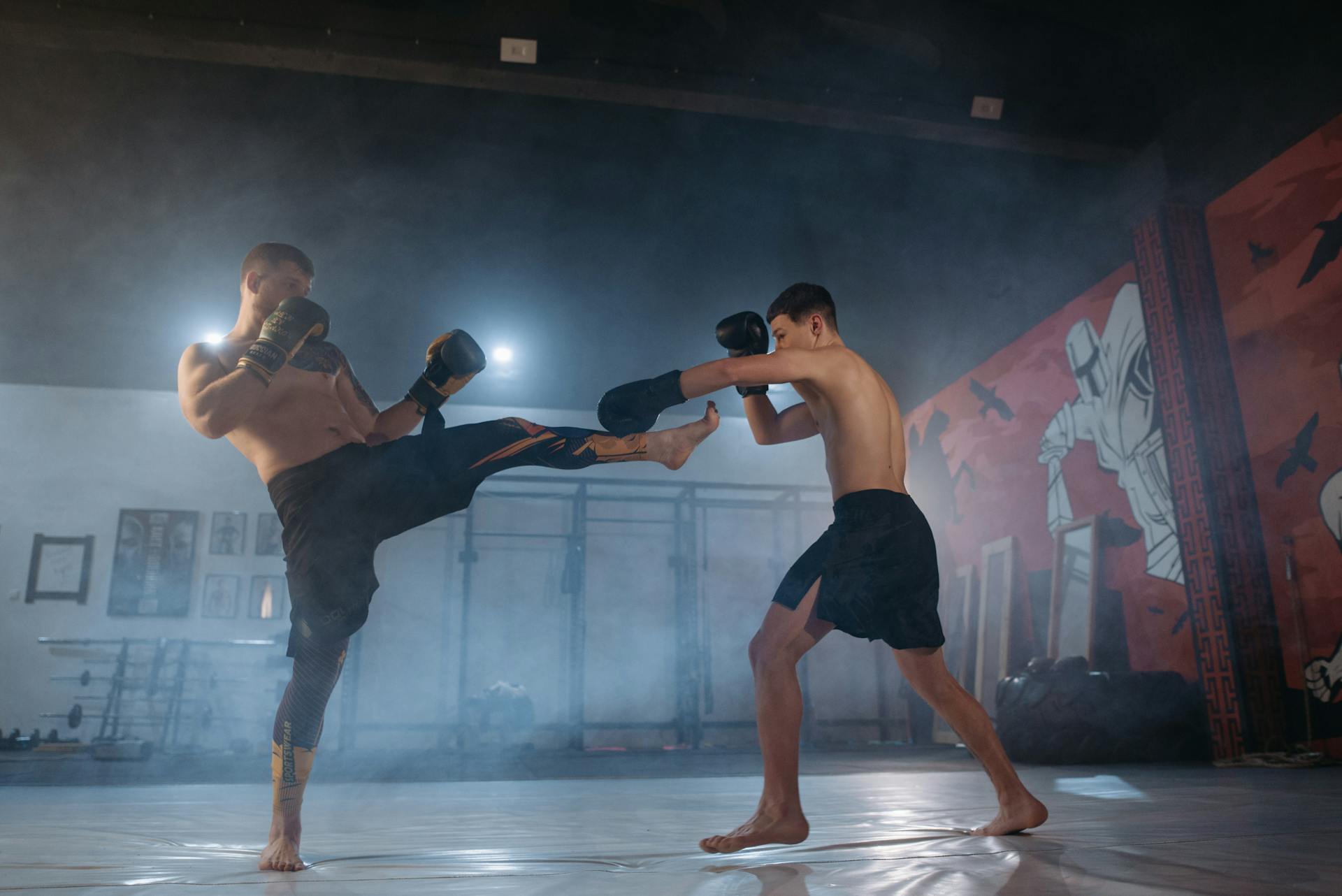
Here's a breakdown of the costs and duration of intermediate agility classes:
The Agility Skills Class is a great option for intermediate handlers who want to work on specific skills like weave poles, building speed, and obstacle discrimination. This class is designed for students already working at the intermediate level and requires enrollment in a current class.
At K9U Chicago, intermediate agility classes are available for one dog and handler, with a cost of $250 for a 5-week class. The focus is on individual skills and complex sequencing, allowing your dog to gain distance and independence on each obstacle.
Skills Class
Skills Class is a great way to take your agility training to the next level. It's specifically designed for students who have already mastered the basics and are looking to improve their skills and performance.
In a Skills Class, you'll work on individual skills like weave poles, building speed, obstacle discrimination, treadles, backsides, distance, and more complex skills that will help you advance your coursework performance. This class is only available to students who are already working at the Intermediate level and are currently enrolled in a class.
Discover more: Canine Performance Events Agility Trials
The cost of a Skills Class is $150 for 6 weeks, making it a great value for the level of instruction and guidance you'll receive. It's a great opportunity to focus on specific skills and work with your trainer to develop a customized training plan.
Here are some of the skills you can expect to work on in a Skills Class:
Overall, a Skills Class is a great way to take your agility training to the next level and improve your skills and performance.
Competition Process
Competition trials are usually hosted by a specific local club that contracts with licensed judges and applies to the sanctioning organization for permission to hold a trial on a specific date or weekend.
Most trials are two-day weekend events, where dogs and their handlers compete in various classes.
The club might be devoted solely to dog agility, or it might be primarily a breed club that wants to promote the working abilities of its breed, or it might be a club that hosts many types of dog sports.
Course builders use course maps provided by the judges to place equipment on the course, often with the help of volunteers and a grid system to mark the course.
The judge walks through the course to double-check that the obstacles are legal, placed correctly, and free from hazards.
Recommended read: Akc Agility All-american Dog Breed
International Competitions
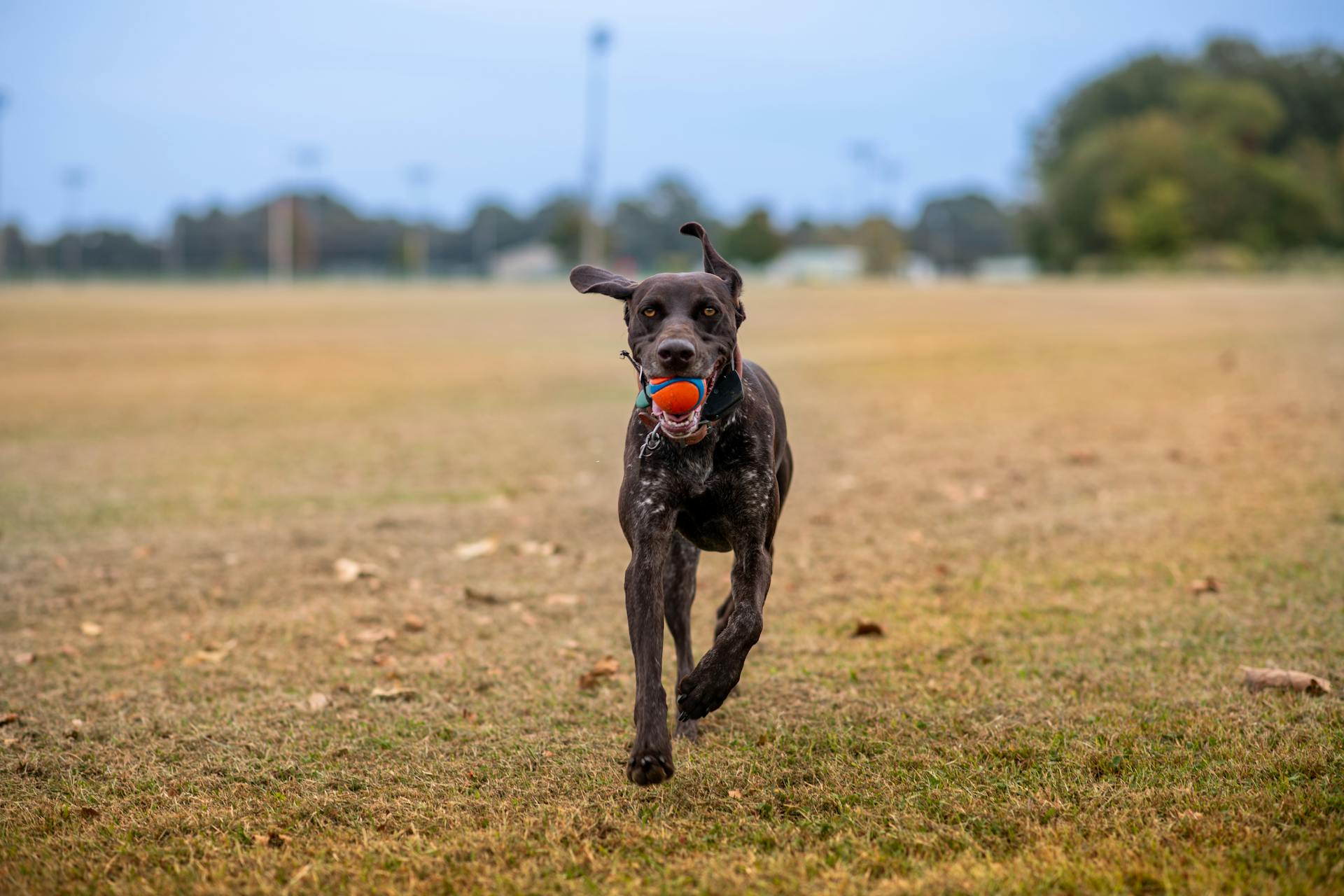
International competitions are a thrilling way for dogs and their handlers to showcase their skills. The Fédération Cynologique Internationale Agility World Championships, the oldest and best-known, is held every year.
This event was initially held as a European championship until 1995, then shifted to a world championship from 1996, and is restricted to registered pedigree dogs only. This is one of the reasons why alternative organizations emerged to cater to dogs without pedigrees.
The International Mix & Breed Championship in Agility (IMCA) was first held in Italy in 2000 as a response to the FCI pedigree-only championships. This competition is held annually with about 18 countries participating, including teams from outside Europe.
The International Federation of Cynological Sports (IFCS) has organized a biannual world agility championship open to any breed or mixed-breed dog regardless of pedigree since 2002. This event has gained popularity since 2013 and is now held every year.
Recommended read: Championship (dog)
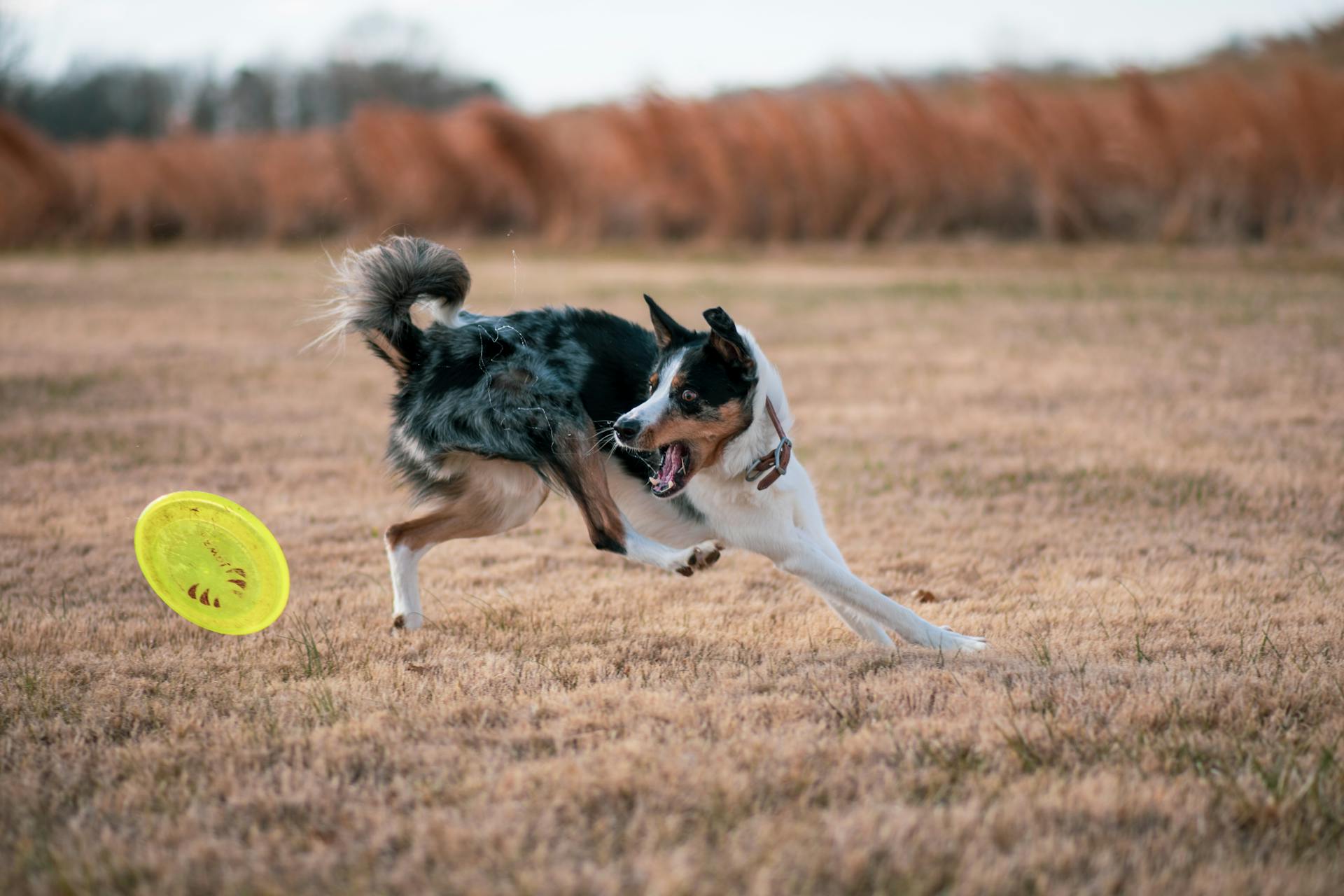
The Cynosport World Games, established in 2003, consolidated USDAA's three tournament series and exhibitions in other popular canine sports. These tournaments were opened to invited overseas participants for the first time in 2001.
Here's a list of some notable international competitions:
- Fédération Cynologique Internationale Agility World Championships
- International Mix & Breed Championship in Agility (IMCA)
- International Federation of Cynological Sports (IFCS) biannual world agility championship
- Cynosport World Games
- European Open
- World Agility Open Championships (WAO)
- Junior Open Agility World Championships
Competition Locations
Agility competitions require a significant amount of space, with each ring typically needing at least 5,000 square feet.
The ground must be non-slip and level, usually being either packed dirt, grass, carpeting, or padded matting.
Competitors need space to set up quarters for their dogs and gear, often bringing pop up canopies or screenroom awning tents for shade.
Dogs are usually left to rest in exercise pens, crates, or dog tents, which are familiar and enclosed environments that help them relax and recover between runs.
Handlers also bring reflective cloths to protect their dogs from sun exposure and to calm them down by covering their crates with the cloths.
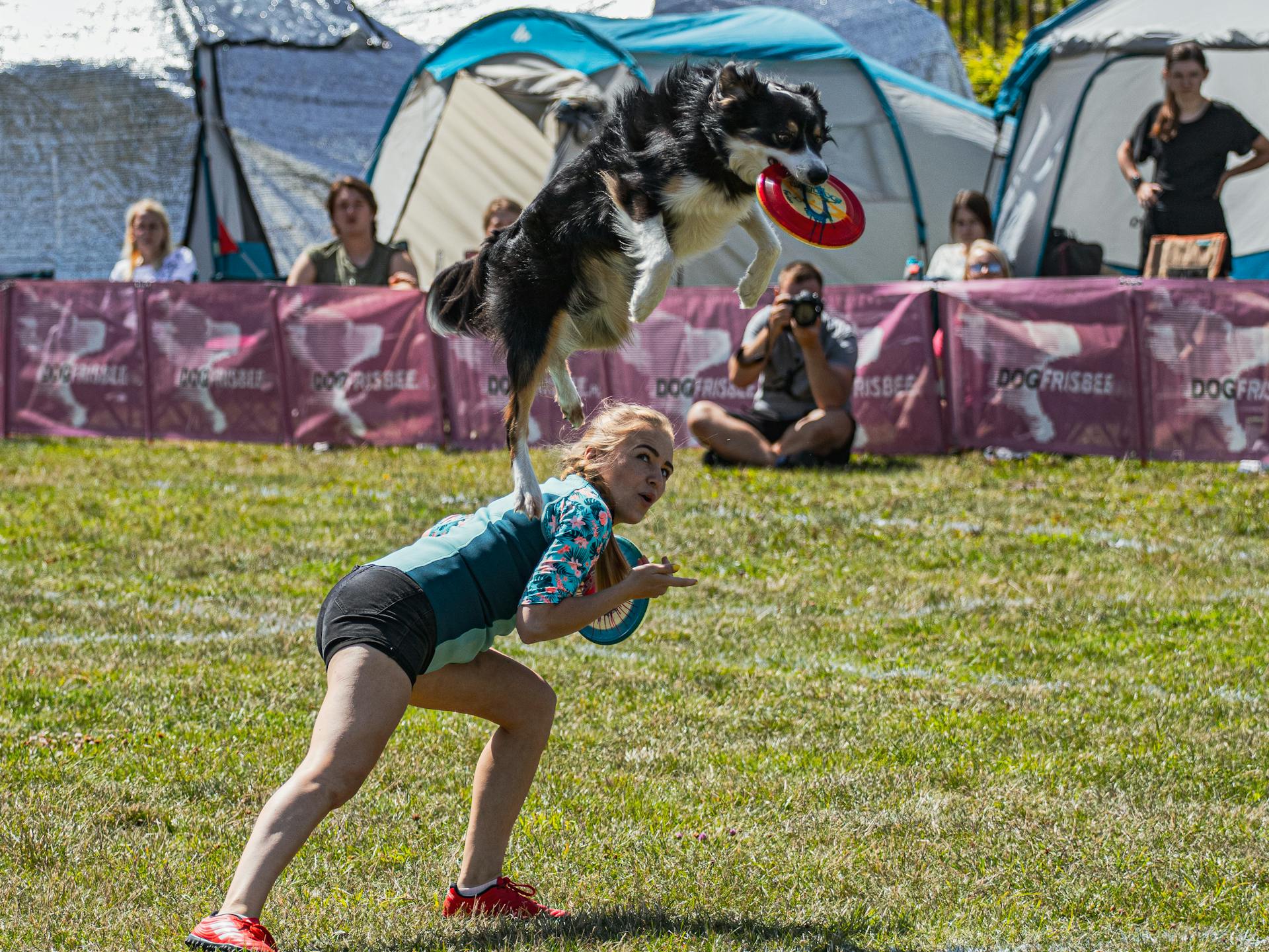
Space must be available for many handlers with dogs on leashes to move freely around the rings without crowding, and space for warming up, exercising, and pottying dogs.
In heavily populated areas, it's uncommon to find real estate inexpensive enough to devote entirely to agility, so sites are usually rented for the weekend.
Popular locations for agility competitions include large parks, covered horse-riding arenas, and in cold-winter areas, large, empty warehouses in which mats or carpet can be laid.
A different take: Flirt Pole for Large Dogs
Course Results
The judge's briefing before each class reviews the rules and explains specific requirements for a particular course. This is especially important for novice handlers in classes with complex rules.
Competitors then walk the course, and the gate steward or caller ensures that dogs enter the ring in the running order previously determined by the trial secretary. This helps prevent conflicts with other rings of competition.
As each dog and handler team runs the course, the dog is timed either by a person with a stopwatch or with an electronic timer. The scribe writes the judge's calls and the dog's final time on a scribe sheet or ticket.
Suggestion: Akc Dog Agility Rules
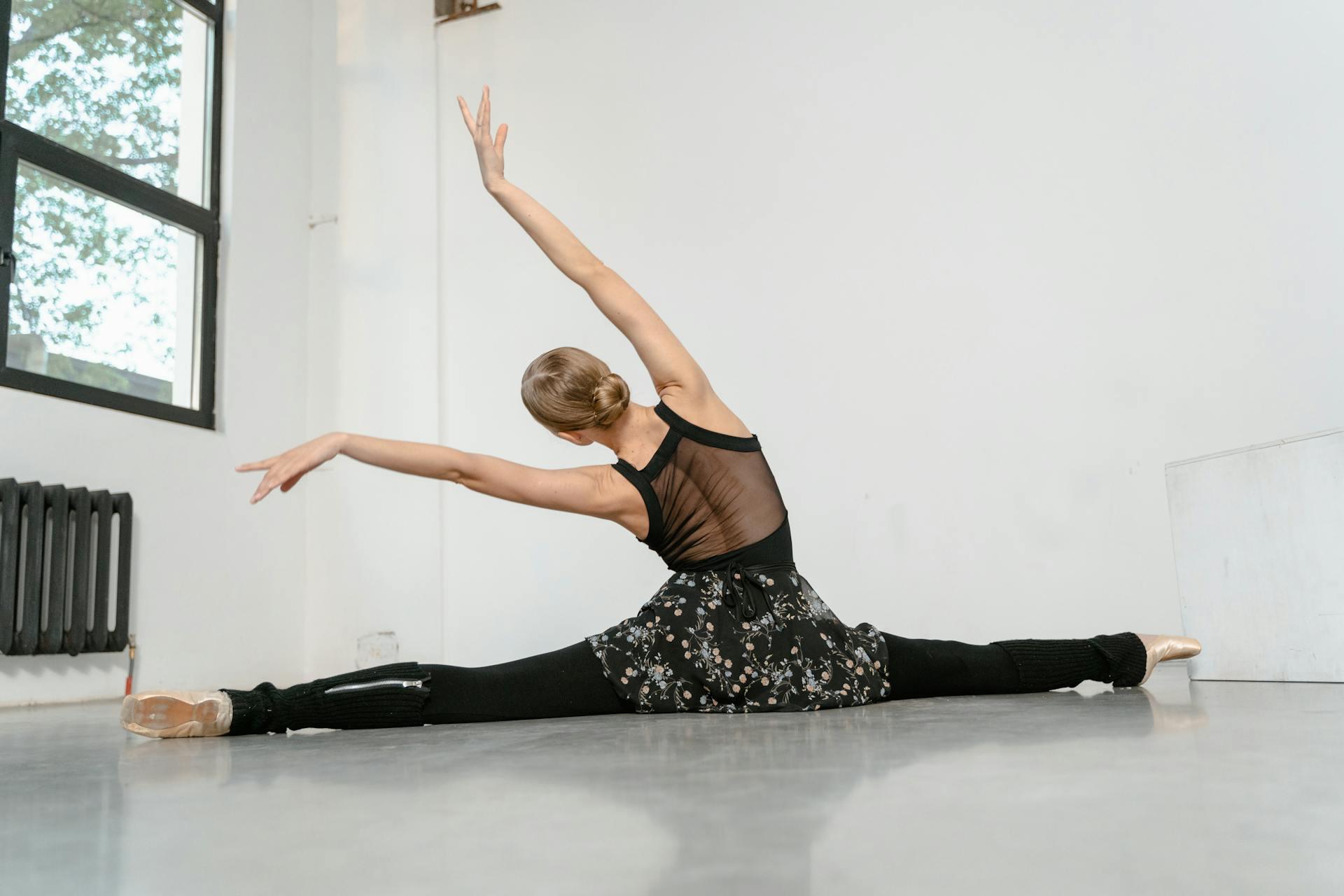
At the score table, scorekeepers compile the results in a variety of ways, including computerized scorekeeping or manual score sheets. Some organizations require or encourage one method over the other.
Each ring might run several classes during a day of competition, requiring multiple course builds, walk-throughs, and briefings. This can be a complex process, but it's essential for ensuring fair and accurate results.
Advanced Competition
To take your agility skills to the next level, you'll need to have a solid foundation in basic obedience, beginner agility, and intermediate agility.
You'll be focusing on sequencing, teaching complex behaviors, and increasing your dog's verbal independence.
This class will put your foundation skills to the test by breaking down complex courses and applying them to real-life situations.
You'll learn how to troubleshoot common challenges that arise in the ring, such as navigating obstacles and communicating with your dog.
Advanced competition agility requires a lot of practice and patience, but the reward is well worth it.
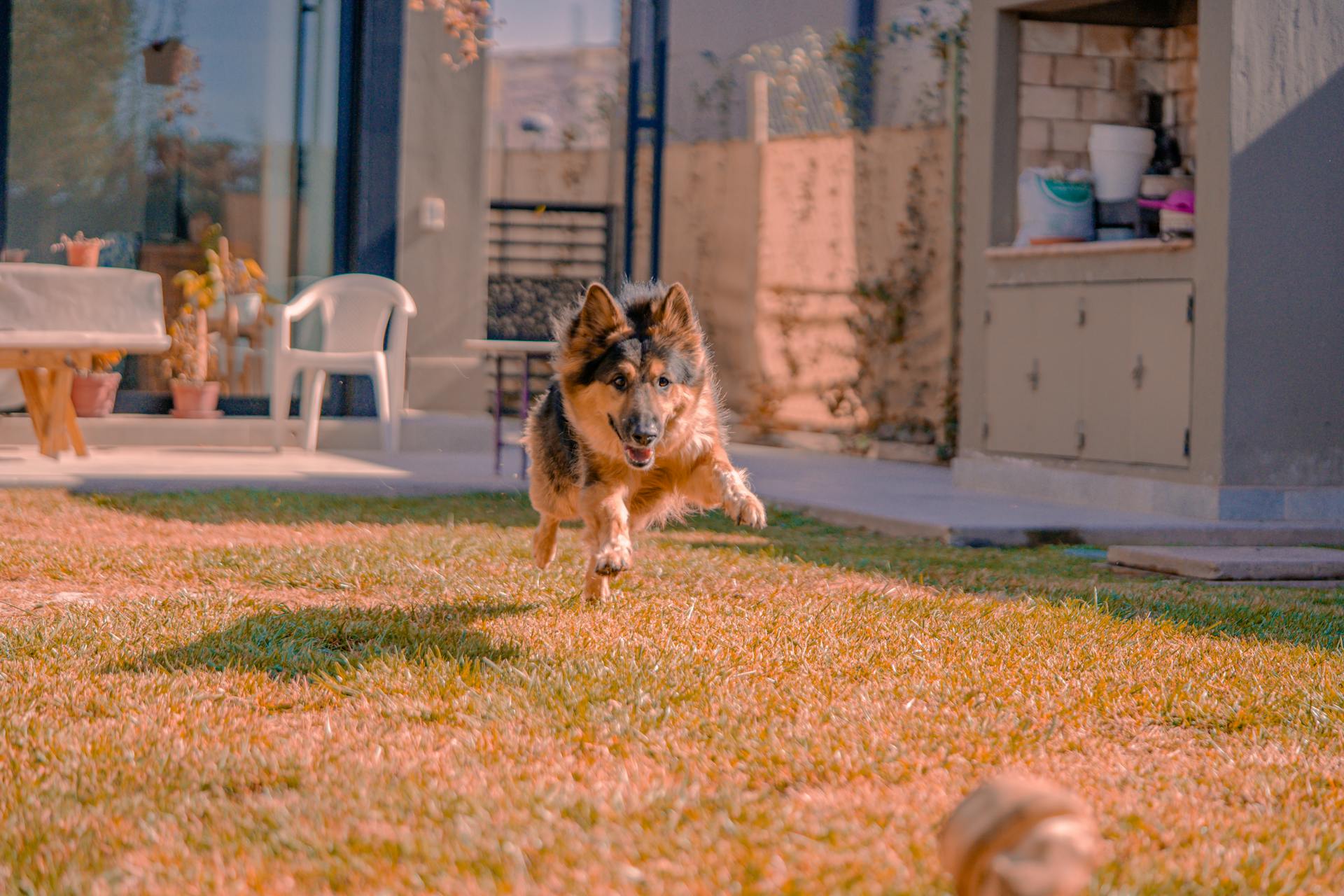
You'll gain a deeper understanding of how to read courses, identify potential problem areas, and develop strategies to overcome them.
This class will also prepare you for your first agility trial, teaching you what to expect and how to stay calm under pressure.
By the end of this class, you'll have a solid understanding of advanced competition agility and be ready to take on more complex courses and challenges.
Intriguing read: Dog Agility Courses
Frequently Asked Questions
What age should a dog start agility?
Dogs should start agility training between 12-18 months of age, after they've reached full physical maturity. This ensures they can safely participate in the physically demanding sport
Can any dog be an agility dog?
While any dog can be trained for agility, some breeds are better suited due to their energy level and physical aptitude. Certain breeds may face challenges due to health conditions affecting movement or exercise.
What are the levels of agility dogs?
Agility dogs advance through 7 levels, from Grade 1 (beginner) to Grade 7 (expert), with progression determined by wins at each level. Competitors can earn their way up the grades with a set number of victories.
Featured Images: pexels.com
